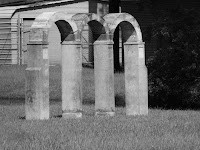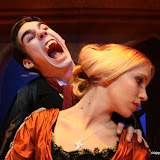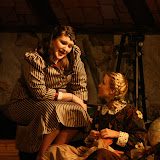Wednesday, September 24, 2008
the duchess
Tuesday, September 23, 2008
Watercolour tutorial for costume rendering
Midnight Oil
And work by Mark Khaisman. Packaging tape on plexiglas:


Monday, September 22, 2008
cochineal--and you thought lizard fuel was safe
A red dye worth rubies:
Until the invention of synthetic dyes, all the red colorants—archil madder, brazilwood, murex, and cochineal—were expensive and greatly prized. Cochineal dye has been in use since the empire of ancient Egypt. In the 1500s, discovery of sources in Mesoamerica brought untold wealth to the Spanish, who guarded the secret of its manufacture well.
Cochineal: the gold that did not glitter
A color plant, a mollusk, or a scale insect does not announce, through its leaves, fruits, or glands, the presence of any dyestuff. Only the dyer knows that through his chemical manipulations, brilliant and hardy colors can be derived from the often unattractive natural materials. One day in the middle of the 1700s, the crew of one of the Caribbean’s most feared pirate ships learned that both colorful and pecuniary riches could be hidden in very humble dress. They sighted a large Spanish ship outside the coast of Honduras with a presumed load of gold and silver intended to enrich the Spanish crown, a circumstance of ownership that they decided to change rapidly by catching up with and boarding the ship. The Spaniards were quick and managed to avoid their pursuers. In their haste to escape, the longboat was left behind and was captured by the pursuers. The pirates’ disappointment over having captured only the longboat filled with worthless bags of dried brown grain quickly changed to happiness when they realized that the contents consisted of the “scarlet grain”—the fabulous, expensive raw material for the red dyestuff carmine!
At the time of this event the origin of the “scarlet grain” was still unknown in Europe. However, rumor had it that the Spaniards got it, along with other precious goods, far away in the mysterious countries on the other side of the Atlantic.
The areas of origin and the early use of cochineal
The valuable but outwardly insignificant small grain was nothing other than dried females of the insect family Dactylopius, long called cochineal. Despite the fact that cochineal had been introduced to Europe before the end of the 1500s, uncertainty about the true nature of the dyestuff reigned long into the 1700s. The cause was simple enough. For the Spaniards, the sought after good was of the greatest economic importance and they did everything they could to keep its existence and production a secret. Various written Spanish sources from the 1500s give evidence of the sensitive nature of the substance. Early works kept silent or were directly misleading about actual conditions. Later, what were for the most part correct descriptions, remained unnoticed or not believed. In fact, the Spanish authorities encouraged this lack of knowledge, making it more difficult for foreigners to gain a collective picture of the manner of production and work methods used in cochineal factories.
The cochineal scale insect originates in South and Central America, where the Indians already used the carmine color for dyeing textiles in 1000BC. When the Spaniards went to Mexico in the early 1500s, the dyestuff became frequently used. From Mexico its use spread to other countries, including Peru. The old Aztec term for the color was “nochezli”, which the Spaniards changed to “cochinilla”. Eventually the French form of the word, “cochenille”, became the most used.
Red from the other side of the ocean.
The Latin American countries’ original production of cochineal should have been limited in scope and only intended to meet the needs of domestic textile production. After the Spaniards arrived, large-scale production of the valuable dyestuff was introduced and it eventually became one of the most important sources of income for the colonial power, aside from the export of silver. It has been calculated between the years of 1758 and 1858, no less than 27,000 tons of cochineal were shipped out of Mexico. The picture of the extent of cochineal production becomes even clearer if data about the size of the plantations is considered. Each plantation consisted of no less than 50,000 cactus plants. The increasing demand was partly because the European and the Asian dye works discovered that Mexican cochineal had a higher content of actual dyestuff than the Polish and Armenian color scale kermes insects which had been used up to that time.
Thus, export was to Europe alone. In the 1580s, cochineal was transferred with loads of silver from Acapulco on the Tehuantepec isthmus to Manila on the Philippines. The dyestuff was also found in China from the time of the emperor Kang-Hsis (1662-1722). This far-sighted ruler was not only the promoter of the first great Chinese map and a great literary encyclopedia of over 5,000 volumes, but he was also the one who gave the French and British the right to conduct trade between China and the Occident. He was aware that “Ko-tcha-ni-la” was a product of a Latin American insect and that it was introduced by the Europeans. The carmine color went (and still goes) under the name of “foreign root”, Yang Hung. Yang actually means ocean, so the expression could also be translated as “red from the other side of the ocean”. Compare this to our word ultramarine (the blue gemstone lapis lazuli, from the other side of the ocean).
The spread of the cochineal scale insect to new areas
The Spaniards brought the dried cochineal insect to Europe where the carmine dyestuff was then extracted, packed and sold to waiting consumers. To ensure sole right to the product, the Spanish government prohibited all forms of import of living scale insects to the European continent. Despite constant prohibitions that included a ban on exporting the mother strain of cochineal from Mexico to bordering Latin American areas, by the end of the 1700s, breeding had spread across the borders of the country to Guatemala, Brazil, and to the Indonesian island of Java. Later, plantations were also started on several of the West Indian islands, in Algeria, and on the Canary Islands. The monopoly that the Spaniards had ever since Cortez conquered Mexico in 1519 was thereby broken, and the consumers could be supplied with the cochineal dyestuff from a number of different markets: the French from Veracruz, the Dutch, from Java, and the English from India.
Thursday, September 18, 2008
Wednesday, September 17, 2008
the movie's best-loved costumes
http://www.time.com/time/photogallery/0,29307,1699703,00.html
Friday, September 12, 2008
Body Painting
http://www.pixcetera.com/pixcetera/2008-world-body-painting-day/32599?icid=200100397x1209587962x1200528207
Bayeux Tapestry

Nobles feasting. Detail of the Bayeux Tapestry – 11th century; by special permission of the City of Bayeux
Cooks are depicted preparing and serving a banquet on the Bayeux Tapestry. A raiding party returned from the countryside with a cow, sheep or pig. The feast was cooked in the open air, roasted on spits, while a cauldron bubbled over a fire. The food was passed to the servants, who ate the coarser fare on a table assembled from shields. They in turn served their masters who sat at table and dined in some style.
Thursday, September 11, 2008
Little Laugh might do you some good.
Drawing on the Right Side of the Brain
Betty Edwards has used the terms L-Mode and R-Mode to designate two ways of knowing and seeing - the verbal, analytic mode and the visual, perceptual mode - no matter where they are located in the individual brain. You are probably aware of these different characteristics. L-mode is a step-by-step style of thinking, using words, numbers and other symbols. L-mode strings things out in sequences, like words in a sentence. R-mode on the other hand, uses visual information and processes, not step-by-step, but all at once, like recognizing the face of a friend.
"You have two brains: a left and a right. Modern brain scientists now know that your left brain is your verbal and rational brain; it thinks serially and reduces its thoughts to numbers, letters and words… Your right brain is your nonverbal and intuitive brain; it thinks in patterns, or pictures, composed of ‘whole things,’ and does not comprehend reductions, either numbers, letters, or words."
From The Fabric of Mind, by the eminent scientist and neurosurgeon, Richard Bergland. Viking Penguin, Inc., New York 1985. pg.1
Most activities require both modes, each contributing its special functions, but a few activities require mainly one mode, without interference from the other. Drawing is one of these activities.
Learning to draw, then, turns out not to be "learning to draw." Paradoxically, "learning to draw" means learning to make a mental shift from L-mode to R-mode. That is what a person trained in drawing does, and that is what you can learn.
If you have not had contact with this book, it may be a good thing to go through. It is a self study, and can easily be done in a week with no school (possibly christmas break?) It will help teach you how to "SEE" things differently, or, rather, correctly.
Wednesday, September 10, 2008
A Tutu is Born



Tuesday, September 9, 2008
My summer project
edit: I mentioned to my mom that I put up the pictures and she advised me to take them down. Just in case someone accidentally came across this blog. I wasn't thinking. If anyone wants to see the pictures just ask me.
Tyrian Purple
“
... the Tyrian hue ... is considered of the best quality when it has exactly the colour of clotted blood, and is of a blackish hue to the sight, but of a shining appearance when held up to the light; hence it is that we find Homer speaking of "purple blood."
”
Archaeological data from Tyre indicate that the snails were collected in large vats and left to decompose. This produced a hideous stench that was actually mentioned by ancient authors. Not much is known about the subsequent steps, and the actual ancient method for mass-producing the two murex dyes has not yet been successfully reconstructed; this special "blackish clotted blood" colour, which was prized above all others, is believed to be achieved by double-dipping the cloth, once in the indigo dye of H. trunculus and once in the purple-red dye of M. brandaris.
-wikipedia
In my opinion wikipedia should be double checked at every turn but, this is very similar to the way the process was explained to me in school and is eaisly checkout on via other sources on the web and in books.
What we went through for purple...amazing.
Mood Fabric Store in NYC


 This summer I took a trip to New York City. The number one stop on my list was the Mood fabric store. If your not familiar with it, it's the fabric store they use on Project Runway. The store has three stories filled with aisles and walls full of fabric, buttons, closures and many other findings. I was blown away by the amount of fabric. I could hardly concentrate when trying to find fabric to buy. If you ever have a chance to go to NYC and is interested in the fashion world, Mood is a great place to check out!
This summer I took a trip to New York City. The number one stop on my list was the Mood fabric store. If your not familiar with it, it's the fabric store they use on Project Runway. The store has three stories filled with aisles and walls full of fabric, buttons, closures and many other findings. I was blown away by the amount of fabric. I could hardly concentrate when trying to find fabric to buy. If you ever have a chance to go to NYC and is interested in the fashion world, Mood is a great place to check out!
Monday, September 8, 2008
fun facts!!!! about gem stones

in the early centuries, precious stones were said to have powers that could relieve illness and other uses.
Christian Louboutin Gold Spiked ShowSTOPPERS
Donna Karan Heels

Sunday, September 7, 2008
What to do to be called a Haute Couture Designer

I love shoes in different languages
German: Ich liebe Schuhe
Chinese: 我爱鞋
French: J'aime les chaussures
Spanish: Me encanta los zapatos
Russian: Я люблю обувь
Italian: Amo le scarpe
Arabic: انا احب الاحذيه
will paint for food commentary
Saturday, September 6, 2008
polyester, plastic bags, etc.

OMG, it's like, way cool dude!!!



Now, why didn't we think of that?
Friday, September 5, 2008
The History of Gels

First project for Tuesday night class. Team Loch Ness: Angi, Andy Jean, Arlene, Sam and Charles.

Then it hit me! The Loch Ness Monster! The shape of the arches were perfect and the surroundings were great too.

(Loch Ness Monster sighting)
I thought it would be funny to give our monster a Plaid hat. I also thought that people would be able to tell what it was a little more if they could relate the project with something known for being Scottish (Loch Ness is in Scotland, plaid=Scottish). Arlene suggested a beret. We used the picture below as inspiration for our Scottish clothing for our monster.  (Scottish Style Clothing)
(Scottish Style Clothing)
Our finished project


I'm kind of proud of my beret. I've never made a hat before. It is also one of the first items I have ever made without the use of a pattern.
Great job everyone on this project and the other two as well!
Thursday, September 4, 2008
thats one large jelly bean
past and the present couture dress!
Tuesday, September 2, 2008
Loch Ness Inspiration
 "Classic Nessy Sighting Image"
"Classic Nessy Sighting Image"

Coincidence?
Masquerade knitting
in the spirit of those, i found a really cool blog.
hope everyone finds it as neat as i do.
http://maskerade.blogsome.com/
Loch Ness Monster


From the group: Sam, Arlene, Andy-Jean, Angie, Charles:
Upon observing the concrete arches with their flowing curves, our imaginations began to conjure up images of water and movement. By using a creature that is said to always be seen in motion, we were able to portray movement which we first saw in our object. The location of the arches closely resembled the surroundings and mystique of the Scottish legend. We decided to depict the Loch Ness Monster emerging from the water to show the motion and the curves of the arches. We took advantage of the existing arches and made them the creature’s back. By dividing the space between the flowing free shape of the arches and the rigid vertical columns that uphold and imprison them, we uprooted the figure and gave life to an otherwise stationary object. We used water to change the stiff unmoving columns into something free and flowing. To pay tribute to the legend’s origins and to add a hint of fantasy, we constructed the traditional beret and sash out of a plaid fabric similar to the tartans of Scotland. We are able to capture the grace and finesse of Nessy as she glides from the past onto our campus.
















